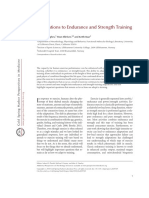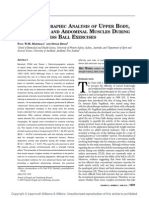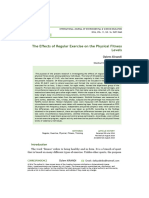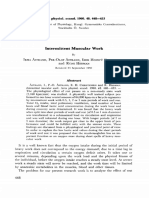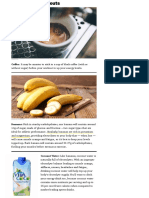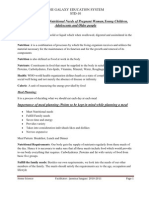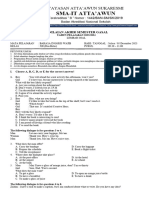Article
Article
Uploaded by
Paulo PiresCopyright:
Available Formats
Article
Article
Uploaded by
Paulo PiresCopyright
Available Formats
Share this document
Did you find this document useful?
Is this content inappropriate?
Copyright:
Available Formats
Article
Article
Uploaded by
Paulo PiresCopyright:
Available Formats
ORIGINAL RESEARCH
published: 03 April 2017
doi: 10.3389/fphys.2017.00172
Functional High-Intensity Circuit
Training Improves Body Composition,
Peak Oxygen Uptake, Strength, and
Alters Certain Dimensions of Quality
of Life in Overweight Women
Billy Sperlich 1*, Birgit Wallmann-Sperlich 2, 3 , Christoph Zinner 1 , Valerie Von Stauffenberg 1 ,
Helena Losert 1 and Hans-Christer Holmberg 4, 5
1
Integrative and Experimental Exercise Science, Institute of Sport Science, University of Würzburg, Würzburg, Germany,
2
Institute of Sport Science, University of Würzburg, Würzburg, Germany, 3 Institute of Health Promotion and Clinical
Movement Science, German Sport University Cologne, Cologne, Germany, 4 School of Kinesiology, University of British
Columbia, Vancouver, BC, Canada, 5 School of Sport Sciences, University of Tromsø—Arctic University of Norway, Tromsø,
Norway
Edited by: The effects of circuit-like functional high-intensity training (CircuitHIIT ) alone or in
Luca Paolo Ardigò,
combination with high-volume low-intensity exercise (Circuitcombined ) on selected
University of Verona, Italy
cardio-respiratory and metabolic parameters, body composition, functional strength and
Reviewed by:
Beat Knechtle, the quality of life of overweight women were compared. In this single-center, two-armed
University of Zurich, Switzerland randomized, controlled study, overweight women performed 9-weeks (3 sessions·wk−1 )
Alessandro Moura Zagatto,
Universidade Estadual Paulista Júlio of either CircuitHIIT (n = 11), or Circuitcombined (n = 8). Peak oxygen uptake and
Mesquita Filho, Brazil perception of physical pain were increased to a greater extent (p < 0.05) by CircuitHIIT ,
Hassane Zouhal,
whereas Circuitcombined improved perception of general health more (p < 0.05). Both
University of Rennes 2—Upper
Brittany, France interventions lowered body mass, body-mass-index, waist-to-hip ratio, fat mass, and
*Correspondence: enhanced fat-free mass; decreased ratings of perceived exertion during submaximal
Billy Sperlich treadmill running; improved the numbers of push-ups, burpees, one-legged squats,
billy.sperlich@uni-wuerzburg.de
and 30-s skipping performed, as well as the height of counter-movement jumps; and
Specialty section: improved physical and social functioning, role of physical limitations, vitality, role of
This article was submitted to emotional limitations, and mental health to a similar extent (all p < 0.05). Either forms
Exercise Physiology,
a section of the journal
of these multi-stimulating, circuit-like, multiple-joint training can be employed to improve
Frontiers in Physiology body composition, selected variables of functional strength, and certain dimensions of
Received: 03 January 2017 quality of life in overweight women. However, CircuitHIIT improves peak oxygen uptake
Accepted: 07 March 2017
to a greater extent, but with more perception of pain, whereas Circuitcombined results in
Published: 03 April 2017
better perception of general health.
Citation:
Sperlich B, Wallmann-Sperlich B, Keywords: aerobic fitness, body composition, female, functional training, interval training, power training
Zinner C, Von Stauffenberg V,
Losert H and Holmberg H-C (2017)
Functional High-Intensity Circuit
Training Improves Body Composition,
INTRODUCTION
Peak Oxygen Uptake, Strength, and
Alters Certain Dimensions of Quality of
Programs designed to improve cardiovascular, metabolic, and psychological health have begun
Life in Overweight Women. to replace low-intensity exercise by repeated short-to-long bouts of high-intensity exercise with
Front. Physiol. 8:172. intervals of recovery [referred to as high-intensity interval training (HIIT)] (Kessler et al., 2012;
doi: 10.3389/fphys.2017.00172 Little and Francois, 2014; Elliott et al., 2015; Gielen et al., 2015; Schmitt et al., 2016). In addition
Frontiers in Physiology | www.frontiersin.org 1 April 2017 | Volume 8 | Article 172
Sperlich et al. Functional High-Intensity Circuit Training in Overweight
to allowing an unlimited number of protocols with different All were informed in detail about the design of the study,
work-to-rest ratios, order of loading and distribution of training the potential risks and benefits, before providing their written
intensity, HIIT requires less time than low-intensity-high- consent to participate. The inclusion criteria were an age of 18–
volume training, which is attractive, since lack of time appears 35 years and BMI >25 kg·m−2 ; not having engaged in routine
to be one of the major reasons for not exercising (Godin et al., exercise programs for at least 6 months prior to the study; no
1994). daily intake of medication; and completion of more than 80% of
In contrast to the traditional endurance-based HIIT, a the training sessions.
relatively novel variation also called functional training/fitness Each woman visited the laboratory once before the actual
incorporates multi-stimulating, circuit-like, multiple-joint, high- study to become comfortable performing all exercises. All
intensity training (CircuitHIIT ), and becoming of increasing procedures were conducted in accordance with the Declaration
interest to fitness enthusiasts (Buckley et al., 2015). Such of Helsinki and the protocol was pre-approved by the ethical
exercise more related to strength can improve body composition review board of the Sport Science Institute of the University of
(Sillanpää et al., 2009; Neves et al., 2017), as well as cardiovascular Würzburg.
(Shaw and Shaw, 2009; Ho et al., 2012a,b), metabolic (Schumann
et al., 2014; Neves et al., 2017) and functional fitness (Neves Overall Study Design
et al., 2017) in physically inactive individuals and, in addition, All of the women completed a 9-week intervention involving 3
at least in older individuals, certain aspects of quality of sessions of either CircuitHIIT or Circuitcombined each week. The
life (Sillanpää et al., 2012). However, with increasing exercise overall timeline of this intervention is illustrated in Figure 1.
intensity, enjoyment declines, and the excessive demands made Pre- and post-training testing included assessment of
by HIIT have been proposed to diminish intrinsic motivation and body composition, a treadmill ramp test to assess cardio-
discourage adherence to further exercise (Hardcastle et al., 2014). respiratory, and metabolic parameters, numerous tests of
Strength exercise such as CircuitHIIT , is well known to functional movement, and a questionnaire concerning quality of
elevate muscle mass and thereby potentially reduce numerous life. Baseline testing was completed during two visits at least 48 h
risk factors for cardiovascular disease (Hurley et al., 1988; apart and before assigning the women to one of the interventions.
Poehlman et al., 2000). In contrast, low-intensity endurance Post-intervention testing, also in two sessions at least 48 h apart,
exercise is known to augment plasma volume (Green et al., 1987, commenced 72 h after the final training session.
1990), muscular blood flow (Coyle, 1999), and capillary and
mitochondrial densities (Hoppeler and Weibel, 2000) thereby The Interventions
improving peak oxygen uptake (Hickson et al., 1981). Improved The 3 weekly sessions of CircuitHIIT were performed either
cardiorespiratory fitness (e.g., maximum oxygen uptake) has indoors or outdoors, while Circuitcombined involved two sessions
been associated with improved health and less premature death of the same nature and a third of low-intensity endurance
(Bouchard et al., 2015). Due to the different responses evoked, exercise targeting 65% of peak heart rate (see Table 1 for
functional strength training in the form of CircuitHIIT combined additional details). Heart rate, especially during the third session
with low-intensity endurance exercise (Circuitcombined ) may lead during weeks 1, 4, and 7, second session during weeks 2, 5, and 8
to synergistic improvements in cardio-respiratory and metabolic and weeks 3, 6 and 9 were monitored continuously (Polar M32,
parameters, body composition, functional strength and quality Polar, Oy, Finland).
of life, which, to the best of our knowledge, has not yet been
investigated in detail with respect to overweight women. Anthropometric Data and Body Composition
Accordingly, we compare here the psycho-physiological Height was measured with a folding yardstick with the subjects
responses of physically inactive women performing a multi- standing barefoot. Body fat and fat-free mass were assessed to the
stimulating, circuit-like, multiple-joint conditioning program nearest 0.1 kg with a four-electrode bio-impedance scale (Model
(CircuitHIIT ), or the same program in combination with 1609N; Tanita Corp, Tokyo, Japan) and body-mass-index (BMI;
low-intensity high-volume exercise (Circuitcombined ). On the in kg·m−2 ) then calculated. Since dehydration may affect bio-
basis of the responses discussed above, our hypothesis was impedance analysis, we instructed all women to consume 500 mL
that CircuitHIIT improves functional strength and metabolic of water 1 h before measurement. The minimal circumference
parameters as well as body composition, but may at the same between the iliac crest and rib cage was designated as the waist
time impair quality of life, whereas Circuitcombined improves circumference, the maximal protuberance of the buttocks as the
cardio-respiratory and metabolic parameters and quality of life. hip circumference, and the waist-to-hip ratio calculated. In our
laboratory setting and with repeated measurements, the error of
METHODS measurement for the waist and hip circumferences is 1.6 and
1.4 cm, respectively, in line with previous findings (Dhaliwal and
Participants Welborn, 2009).
In this single-center, two-arm randomized, controlled study, 22
women (age: 23 ± 2 years) recruited via social media platforms The Treadmill Test
and bulletins were initially assigned randomly to perform either After running for 5 min at 6 km·h−1 on a treadmill (Mercury,
CircuitHIIT (n = 11) or Circuitcombined; (n = 8), but three women h/p/Cosmos Sports & Medical GmbH, Nussdorf-Traunstein,
in the latter group had to withdraw due to time constraints. Germany), the submaximal heart rate, oxygen uptake, respiratory
Frontiers in Physiology | www.frontiersin.org 2 April 2017 | Volume 8 | Article 172
Sperlich et al. Functional High-Intensity Circuit Training in Overweight
FIGURE 1 | The timeline and main outcome variables of this study.
exchange ratio, blood lactate concentration, and perceived Bolzano, Italy) separated by a 1-min rest period, with the best of
exertion were all assessed. Thereafter, the speed was increased the three being subjected to further analysis. In the same testing
by 1 km·h−1 each minute until exhaustion for determination device, the number of times each woman could skip rope within
of the peak values of these same parameters (Kuipers et al., a 30-s period was recorded.
2003). Throughout the testing, oxygen uptake, respiratory
exchange ratio and heart rate were monitored with an open Assessment of Quality of Life
circuit breath-by-breath gas and volume analyzer (Metamax 3B, Prior to baseline testing and again before post-testing, all of
Cortex, Leipzig, Germany), employing standard algorithms to the women completed the German version of the health-related
compensate for the delay between oxygen consumption and quality of life questionnaire (SF-36), which has been shown to
generation of the signal. be valid and reliable (Bullinger et al., 1995). This questionnaire
All respiratory data and heart rates were averaged over 30- assesses general health, physical functioning, mental health,
s intervals. The oxygen uptake at 6 km·h−1 was considered to social functioning, vitality, bodily pain, and the roles of physical
be an indicator of running economy, as described elsewhere and emotional limitations, with higher scores (0–100) reflecting
(Barnes and Kilding, 2015). The oxygen uptake during the last better quality of life.
30 s of the test was considered to be maximal if (a) this uptake
increased <1.0 mL min−1 kg−1 with elevated power output, (b)
the respiratory exchange ratio was >1.10, and/or (c) the heart rate
Statistical Analyses
All data were confirmed to be normally distributed by the
was within 5% of the age-predicted maximum. In all cases, at least
Kolmogorov-Smirnov test, so that no transformation was
two of these three criteria were met.
required. Repeated-measures ANOVA [time-point (pre- or
Both after running for 5 min at 6 km·h−1 and at the point of
post-exercise) × group (CircuitHIIT or Circuitcombined )] was
exertion, blood was collected from the right earlobe for analysis
performed for each outcome variable, with an alpha of p <
of lactate (Lactate Pro 2, Arkray KDK, Kyoto, Japan). With this
0.05 being considered statistically significant and indicated by ∗ .
device and in our laboratory setting, the routinely measured
In addition, the values obtained were evaluated by calculating
coefficient of variation in repeated measures for blood lactate at
the effect size partial eta-square (η2p ). The means and standard
rest is 0.07 and 0.04, 0.11, 0.07, 0.06 when running at 70, 80,
deviations (SD) for all data sets were calculated and all statistical
90, and 95% of peak heart rate, respectively. At the same time
tests carried out in the SPSS 22.0 software package for Microsoft.
as blood sampling, the rating of perceived exertion (RPE) was
The smallest worthwhile effect was defined as the smallest Cohen
assessed employing the 6–20-point Borg scale (Borg, 1970).
change in the mean, i.e., 0.2 times the SD of the between-subject
Testing Functional Strength baseline values for all participants (Batterham and Hopkins,
During all tests of functional strength (separated by 3-min 2006). Chances of benefit and harm were assessed qualitatively as
intervals of recovery) the women were asked to perform as follows: <1% almost certainly none, 1–5% very unlikely, 5–25%
many push-ups, leg-levers, burpees, and one-legged squats as unlikely, 25–75% possibly, 75–95% likely, 95–99% very likely,
they could. >99% almost certainly (Hopkins, 2002).
Counter-Movement Jump and 30-s RESULTS
Skipping
The explosive strength of the leg muscles was examined utilizing The women in the CircuitHIIT and Circuitcombined groups
three counter-movement jumps (OptoJump, MicroGate, completed 89 ± 5 and 90 ± 6% of the planned training sessions,
Frontiers in Physiology | www.frontiersin.org 3 April 2017 | Volume 8 | Article 172
Sperlich et al. Functional High-Intensity Circuit Training in Overweight
TABLE 1 | Details of the 9-week CircuitHIIT and Circuitcombined training interventions.
Week Session CircuitHIIT Circuitcombined
1, 4, 7 1 6 series of 6 series of
- 30-s burpees + 30-s recovery - 30-s burpees + 30-s recovery
- 30-s skipping + 30-s recovery - 30-s skipping + 30-s recovery
- 30-s pull-ups + 30-s recovery - 30-s pull-ups + 30-s recovery
- 30-s 1-legged squats + 30-s recovery - 30-s 1-legged squats + 30-s recovery
- 30-s leg levers + 30-s recovery - 30-s leg levers + 30-s recovery
- 30-s push-ups + 30-s recovery - 30-s push-ups + 30-s recovery
7-min Shuttle run 7-min Shuttle run
2 3 series of 3 series of
- 30-s run/burpees +30-s recovery - 30-s run/burpees +30-s recovery
- 30-s burpees + 30-s leg levers - 30-s burpees + 30-s leg levers
- 60-s lunges + 1-min isometric squat - 60-s lunges + 1-min isometric squat
- 45-s rows + 1-min recovery - 45-s rows + 1-min recovery
- 8x20-s burpees/plank + 10-s recovery - 8x20-s burpees/plank + 10-s recovery
3 5 series of 4 series of
- 30-s burpees + 30-s recovery - 10-min jogging + 5-min walking
- 30-s 1-legged squats + 30-s recovery
- 30-s push-ups + 30-s recovery
- 30-s crunches + 30-s recovery
2, 5, 8 1 3 series of 3 series of
- 45-s lunges/sprints + 30-s recovery - 45-s lunges/sprints + 30-s recovery
- 45-s isometric squat + 30-s recovery - 45-s isometric squat + 30-s recovery
- 60-s 1-legged squats + 30-s recovery - 60-s 1-legged squats + 30-s recovery
- 45-s side lunges/sprints + 30-s recovery - 45-s side lunges/sprints + 30-s recovery
- 45-s isometric sumo squat + 30-s recovery - 45-s isometric sumo squat + 30-s recovery
- 45-s pushups + 30-s rows + 30-s recovery - 45-s pushups + 30-s rows + 30-s recovery
- 30-s plank+30-s skipping + 30-s recovery 30-s plank+30-s skipping + 30-s recovery
2 10 series of 4 series of
- 20-s isometric pull-up/push-up + 40-s run + 30-s - 10-min jogging + 5-min walking
recovery
- 30-s squats/squat jumps + 30-s run + 30-s
recovery
3 series of
- 45-s rows + 45-s burpees + 3x 30-s lunges +
30-s run + 30-s recovery
- 60-s leg levers + 30-s recovery
3 3 series of 10 series of
- 60-s burpees/run + 30-s recovery - 20-s isometric pull-up/push-up + 40-s run + 30-
- 30-s inchworms/lunges s recovery 30-s squats/squat jumps + 30-s run +
5 series of 30-s recovery
- 60-s run + 30-s recovery 3 series of
- 45-s rows + 45-s burpees 3x 30-s lunges + 30-s
run + 30-s recovery
60-s leg levers + 30-s recovery
3, 6, 9 1 2 series of 2 series of
- 60-s jump squats + 30-s recovery - 60-s jump squats + 30-s recovery
- 60-s isometric squat + 30-s recovery - 60-s isometric squat + 30-s recovery
- 60-s burpees + 30-s recovery - 60-s burpees + 30-s recovery
- 60-s 1-legged squats + 30-s recovery - 60-s 1-legged squats + 30-s recovery
- 60-s iron mikes + 30-s recovery - 60-s iron mikes + 30-s recovery
- 60-s skipping run + 30-s recovery - 60-s skipping run + 30-s recovery
10-min Shuttle run 10-min Shuttle run
2 3 series of 3 series of
- 60-s pull-ups + 30-s recovery - 20-min jogging + 10-min walking
- 60-s jump rope + 30-s recovery
- 60-s push-ups + 30-s recovery
- 60-s leg levers + 30-s recovery
- 60-s rows + 30-s recovery
- 60-s burpees + 30-s recovery
800-m run
(Continued)
Frontiers in Physiology | www.frontiersin.org 4 April 2017 | Volume 8 | Article 172
Sperlich et al. Functional High-Intensity Circuit Training in Overweight
TABLE 1 | Continued
Week Session CircuitHIIT Circuitcombined
3 3 series 3 series of
- 30-s jumping jacks + 30-s recovery - 60-s pull-ups + 30-s recovery
- Skipping + 30-s recovery - 60-s jump rope + 30-s recovery
- Squats + 30-s recovery - 60-s push-ups + 30-s recovery
- 3-min burpees + 30-s recovery - 60-s leg levers + 30-s recovery
- 30-s plank + 30-s lunges + 30-s recovery - 60-s rows + 30-s recovery
15-min run - 60-s burpees + 30-s recovery
800-m run
respectively. Their pre- and post-values with statistical analysis Numerous investigations have focused on the effect of HIIT
are documented in Tables 2–5. on parameters of cardio-respiratory fitness including VO2peak
Body mass, body-mass index, waist-to-hip ratio and fat mass (Stoggl and Sperlich, 2014; Schmitt et al., 2016; Zinner
declined and fat-free mass increased to the same extent in both et al., 2016). Since this value limits ATP production via
groups (Table 2). oxidative phosphorylation and is thus strongly associated with
Ratings of perceived exertion following either intervention cardiorespiratory fitness, as well as general health and premature
were lower than at baseline. Peak oxygen uptake improved death, it is frequently utilized as an integrative indicator of
to a greater extent following CircuitHIIT than Circuitcombined cardiopulmonary fitness (Bassett and Howley, 2000; Bouchard
(Table 3). et al., 2015). Here, peak oxygen uptake was improved after 9
The number of push-ups, burpees, one-legged squats and 30- weeks with 3 weekly sessions of either CircuitHIIT (10.1%) or
s skipping, as well as the counter-movement jumping height Circuitcombined (4.4%). The overall greater response of VO2peak
improved after both CircuitHIIT and Circuitcombined , with no to high-intensity exercise can be explained by better central
differences between these groups (Table 3). The number of leg- adaptation, including augmented plasma and blood volumes
levers was improved to a greater extent by CircuitHIIT than (Convertino et al., 1980; Green et al., 1987; Graham et al., 2016)
Circuitcombined (Table 4). with elevated stroke volume (Green et al., 1990; Goodman et al.,
Physical and social functioning, vitality, role of emotional 2005).
limitations and mental health improved following both From this point of view, we may conclude that three sessions
CircuitHIIT and Circuitcombined (Table 5). However, perception of CircuitHIIT enhance VO2peak more effectively than two
of physical pain was higher only after CircuitHIIT and perception sessions of CircuitHIIT and one session of low-intensity exercise
of general health was enhanced only by Circuitcombined . (Circuitcombined ).
The CircuitHIIT participants performed primarily resistance
training (i.e., squats, lunges, push-ups, etc.) in combination with
DISCUSSION repeated sprints, with very little rest between these exercises.
Although this regimen was more related to strength, the women
The major findings of this comparison of several psycho- enhanced their cardiorespiratory fitness (i.e., oxygen uptake)
physiological responses of overweight women to 9 weeks of either to an extent similar to that observed with earlier circuit-based
CircuitHIIT or Circuitcombined were as follows: exercise (Gettman et al., 1982; Beckham and Earnest, 2000). A
7–12% increase in peak oxygen uptake following 4–12 weeks of
(1) With CircuitHIIT , perception of physical pain and peak
body weight circuit training is consistent with previous reports
oxygen uptake both rose to a greater extent.
(Gettman et al., 1982; McRae et al., 2012). However, our present
(2) Perception of general health was improved more by
observations reveal that 3 weekly sessions of CircuitHIIT improve
Circuitcombined .
peak oxygen uptake in a time-effective manner.
(3) Both interventions caused the following changes to a similar
Circuitcombined consisted of two of the weekly CircuitHIIT
degree:
sessions and an additional weekly session of high-volume
- lowering of body mass, body-mass index, waist-to-hip exercise (60–105 min at approximately 65% of peak oxygen
ratio, and fat mass and increase in fat-free mass; uptake). In the case of well-trained endurance athletes a
- decreased ratings of perceived exertion during submaximal combination of HIIT and high-volume low-intensity exercise
treadmill running; might be more beneficial than either alone, since a) low-
- improvements in the number of push-ups, burpees, one- intensity endurance exercise (<2 mM blood lactate or ∼55–
legged squats, and 30-s skipping, as well as counter- 85% peak heart rate) allows the body to recover sufficiently
movement jump height; and b) excess HIIT may exert a negative impact on the
- improvements in physical and social functioning, role of autonomic nervous system (Chwalbinska-Moneta et al., 1998;
physical limitations, vitality, role of emotional limitations Esteve-Lanao et al., 2007). Although the combination of low-
and mental health. volume, high-intensity exercise and high-volume, low-intensity
Frontiers in Physiology | www.frontiersin.org 5 April 2017 | Volume 8 | Article 172
Sperlich et al. Functional High-Intensity Circuit Training in Overweight
TABLE 2 | Anthropometric values (means ± SD) for the women in the CircuitHIIT and Circuitcombined groups before and after the intervention.
Parameter Intervention Before After p(T)/p(T ×G) η2p (T)/η2p (T × G) F Mean Qualitative
effecta ± 90% CIb inference
Body mass [kg] CircuitHIIT 79.7 ± 7.5 77.7 ± 8.2 0.02* 0.243 6.41 −2.0 ± 2.1 Likely positive
Circuitcombined 83.0 ± 10.5 82.5 ± 11.0 0.121 0.116 2.62
Body mass index [kg·m−2 ] CircuitHIIT 28.1 ± 2.7 27.3 ± 2.8 0.015* 0.263 7.12 −2.0 ± 2.1 Likely positive
Circuitcombined 28.3 ± 3.3 28.1 ± 3.2 0.124 0.114 2.58
Waist-to-hip ratio CircuitHIIT 0.80 ± 0.06 0.75 ± 0.05 0.003** 0.359 11.2 −5.1 ± 4.6 Unclear
Circuitcombined 0.79 ± 0.03 0.78 ± 0.04 0.340 0.046 0.956
Fat mass [kg] CircuitHIIT 40.0 ± 4.9 38.1 ± 5.6 0.002** 0.401 13.4 −2.5 ± 3.9 Likely positive
Circuitcombined 40.2 ± 4.8 39.2 ± 5.6 0.240 0.068 1.47
Fat free mass [%] CircuitHIIT 26.5 ± 2.4 27.4 ± 2.6 0.003** 0.359 11.2 1.6 ± 2.9 Likely positive
Circuitcombined 26.4 ± 2.0 26.9 ± 2.5 0.340 0.046 0.956
HIIT, high-intensity interval training; p, probability; ηp2 , effect size partial eta-square; T, global effect of time; G, global effect of group; T × G, global effect of Time × Group; F, degrees of
freedom.
*P < 0.05, **P < 0.01 for the differences between groups.
a Refers to Circuit
HIIT minus Circuitcombined .
b ± 90% CI: add or subtract this number from the mean effect to obtain the 90% confidence intervals for the true difference.
TABLE 3 | Cardio-respiratory and metabolic values and perceived exertion (means ± SD) of the women in the CircuitHIIT and Circuitcombined groups
before and after the intervention.
Intervention Before After p(T)/p(T × G) η2p (T)/η2p (T × G) F Mean Qualitative
effecta ± 90% CIb inference
VALUES AT A SUBMAXIMAL RUNNING SPEED OF 6 KM·H−1
Heart rate [bpm] CircuitHIIT 166 ± 18 160 ± 18 0.087 0.140 3.250 −2.3 ± 4.4 Likely positive
Circuitcombined 167 ± 14 165 ± 12 0.424 0.032 0.665
Oxygen uptake [ml·min−1 ] CircuitHIIT 2,070 ± 206 2,110 ± 141 0.742 0.006 0.112 3.4 ± 6.8 Likely positive
Circuitcombined 2,130 ± 311 2,110 ± 304 0.391 0.039 0.770
Respiratory exchange ratio CircuitHIIT 0.93 ± 0.09 0.91 ± 0.10 0.136 0.113 2.430 2.5 ± 8.3 Unclear
Circuitcombined 0.94 ± 0.10 0.89 ± 0.07 0.556 0.019 0.359
Blood lactate concentration CircuitHIIT 4.4 ± 2.0 3.1 ± 1.2 0.017 0.265 6.850 −25.3 ± 17.7 Very likely
[mmol·L−1 ] Circuitcombined 4.0 ± 2.3 3.7 ± 1.7 0.088 0.146 3.25 positive
Ratings of perceived CircuitHIIT 12.0 ± 1.6 9.5 ± 2.0 <0.001*** 0.683 36.6 −7.6 ± 11.5 Likely positive
exertion [a.u.] Circuitcombined 13.1 ± 2.0 11.1 ± 1.9 0.510 0.026 0.452
PEAK VALUES AT THE POINT OF EXERTION
Maximal oxygen uptake CircuitHIIT 2,630 ± 297 2,900 ± 298 <0.001*** 0.612 30.0 5.8 ± 4.9 Very likely
[ml·min−1 ] Circuitcombined 2,560 ± 348 2,670 ± 398 0.038* 0.207 4.95 positive
Respiratory exchange ratio CircuitHIIT 1.23 ± 0.08 1.17 ± 0.08 0.102 0.134 2.95 −2.4 ± 7.6 Unclear
Circuitcombined 1.18 ± 0.09 1.15 ± 0.07 0.591 0.016 0.299
Blood lactate concentration CircuitHIIT 7.0 ± 2.1 8.0 ± 2.8 0.645 0.011 0.220 26.5 ± 37.4 Likely positive
[mmol·L−1 ] Circuitcombined 7.0 ± 2.2 6.5 ± 2.5 0.128 0.118 2.54
Ratings of perceived CircuitHIIT 18.2 ± 1.5 17.9 ± 2.2 0.396 0.038 0.755 0.9 ± 9.2 Unclear
exertion [a.u.] Circuitcombined 17.8 ± 1.8 17.3 ± 1.6 0.801 0.003 0.065
HIIT, high-intensity interval training; p, probability; ηp2 , effect size partial eta-square; T, global effect of time; G, global effect of group; T × G, global effect of Time × Group; F, degrees of
freedom; a.u, arbitrary units.
*P < 0.05, ***P < 0.001 for the differences between groups.
a Refers to Circuit
HIIT minus Circuitcombined .
b ± 90% CI: add or subtract this number from the mean effect to obtain the 90% confidence intervals for the true difference.
exercise (so-called polarized intensity distribution) led to training together with high-volume low-intensity exercise
greater improvements in selected endurance values for elite (Circuitcombined ).
endurance athletes (Stöggl and Sperlich, 2015), our present In the current investigation, the women in the CircuitHIIT
findings indicate that this is not the case for overweight group perceived more pain, with no change in perception of
women performing multi-stimulating, circuit-like, multiple-joint general health. High-intensity strength training with eccentric
Frontiers in Physiology | www.frontiersin.org 6 April 2017 | Volume 8 | Article 172
Sperlich et al. Functional High-Intensity Circuit Training in Overweight
TABLE 4 | Funtional performance (means ± SD) of the women in the CircuitHIIT and Circuitcombined groups before and after the intervention.
Parameter Intervention Before After p(T)/p(T × G) η2p (T)/η2p (T × G) F Mean Qualitative
effecta ± 90% CIb inference
Push-ups [n] CircuitHIIT 7.5 ± 3.6 19.6 ± 4.2 <0.001*** 0.869 119 −23.2 ± 47.8 Unclear
Circuitcombined 4.3 ± 4.0 17.4 ± 6.1 0.663 0.011 0.196
Leg-levers [n] CircuitHIIT 15.7 ± 11.0 58.5 ± 22.3 <0.001*** 0.754 55.0 120.4 , 84.5 Likely positive
Circuitcombined 15.9 ± 8.0 28.3 ± 6.5 0.001*** 0.480 16.6
Burpees [n] CircuitHIIT 9.2 ± 3.7 24.9 ± 9.9 <0.001*** 0.753 57.8 −28.0 ± 33.6 Likely negative
Circuitcombined 7.0 ± 2.7 27.6 ± 10.8 0.321 0.052 1.04
1-Legged squats [n] CircuitHIIT 18.0 ± 8.2 36.9 ± 10.1 <0.001*** 0.868 125 −32.7 ± 24.6 Very likely negative
Circuitcombined 13.7 ± 5.9 39.9 ± 9.4 0.086 0.147 3.28
Counter-movement CircuitHIIT 23.8 ± 7.0 28.3 ± 7.2 0.017* 0.253 6.79 16.4 , 16.8 Likely positive
jump [cm] Circuitcombined 24.8 ± 5.1 25.3 ± 3.2 0.050 0.178 4.33
30-s Skipping [n] CircuitHIIT 84.0 ± 32.2 116 ± 8.3 <0.001*** 0.679 38.0 −19.0 ± 25.1 Likely negative
Circuitcombined 76.6 ± 21.9 136 ± 37.0 0.074 0.167 3.60
HIIT, high-intensity interval training; p, probability; ηp2 , effect size partial eta-square; T, global effect of time; G, global effect of group; T × G, global effect of Time × Group; F, degrees of
freedom.
*P< 0.05, ***P<0.001 for the differences between groups.
a Refers to the Circuit
HIIT minus Circuitcombined .
b ± 90% CI: add or subtract this number from the mean effect to obtain the 90% confidence intervals for the true difference.
TABLE 5 | Quality of Life (arbitrary units, means ± SD) for the women in the CircuitHIIT and Circuitcombined groups before and after the intervention.
Dimension Intervention Before After p(T)/p(T ×G) η2p (T)/η2p (T × G) F Mean Qualitative
effecta ± 90% CIb inference
Physical functioning CircuitHIIT 94 ± 5.5 98 ± 3 0.008** 0.317 8.82 −7.6 ± 10.4 Likely negative
Circuitcombined 87 ± 14 97 ± 4 0.228 0.075 1.55
Role of physical CircuitHIIT 100 ± 0 98 ± 8 0.439 0.032 0.624 0.3 ± 16.1 Unclear
limitations Circuitcombined 95 ± 16 93 ± 17 0.970 0.000 0.001
Pain CircuitHIIT 96 ± 9 74 ± 19 0.008** 0.320 8.93 −24.5 ± 14.3 Very likely negative
Circuitcombined 91 ± 19 90 ± 17 0.016* 0.270 7.04
Perception of general CircuitHIIT 74 ± 15 74 ± 18 0.039* 0.206 4.94 −23.1 ± 16.3 Very likely negative
health Circuitcombined 66 ± 18 83 ± 17 0.037* 0.210 5.05
Vitality CircuitHIIT 58 ± 13 66 ± 10 0.001** 0.427 14.2 −11.7 ± 17.4 Likely negative
Circuitcombined 49 ± 14 63 ± 13 0.336 0.049 0.975
Social functioning CircuitHIIT 77 ± 18 94 ± 10 0.009** 0.306 8.38 18.0 ± 19.8 Likely positive
Circuitcombined 91 ± 10 96 ± 8 0.130 0.116 2.50
Role of emotional CircuitHIIT 73 ± 29 91 ± 22 0.015* 0.273 7.14 3.0 ± 42.0 Unclear
limitations Circuitcombined 77 ± 39 93 ± 21 0.909 0.001 0.014
Mental health CircuitHIIT 72 ± 14 76 ± 11 0.013* 0.285 7.57 −8.0 ± 12.4 Likely negative
Circuitcombined 68 ± 11 79 ± 12 0.222 0.078 1.60
HIIT, high-intensity interval training; p, probability; ηp2 , effect size partial eta-square; T, global effect of time; G, global effect of group; T × G, global effect of Time × Group; F, degrees of
freedom.
*P < 0.05, **P < 0.01 for the difference between groups.
a Refers to Circuit
HIIT minus Circuitcombined .
b ± 90% CI: add or subtract this number from the mean effect to obtain the 90% confidence intervals for the true difference.
components such as those involved in multi-stimulating, circuit- 20% (Weisenthal et al., 2014), but none of the women in either
like, multiple-joint training induces muscle soreness. Although of our groups mentioned any injury. However, elevated pain
in general in adults, perception of muscle pain is attenuated in connection with HIIT may discourage untrained individuals
as training proceeds, (Levinger et al., 2007), the women from performing regular physical activity (Hardcastle et al., 2014;
in the CircuitHIIT group perceived more pain after the 9- Del Vecchio et al., 2015), although previous studies showed
week intervention. The injury rate associated with multi- no effect of high-intensity exercise on perceived pain in female
stimulating, circuit-like, multiple-joint training is approximately patients (Schmitt et al., 2016). Further studies are needed to
Frontiers in Physiology | www.frontiersin.org 7 April 2017 | Volume 8 | Article 172
Sperlich et al. Functional High-Intensity Circuit Training in Overweight
clarify the effect of high-intensity training, especially short- composition, selected parameters of functional strength,
and long-term, on perceived pain. However, CircuitHIIT and and certain dimensions of quality of life in overweight women.
Circuitcombined induced improvements in several dimensions of Moreover, CircuitHIIT improves peak oxygen uptake, which is
quality of life, which are perhaps the most important reasons associated with improved health and less risk for premature
to continue training. To summarize, in the present investigation death (Bouchard et al., 2015), in less training time, but with more
Circuitcombined appears to have augmented certain aspects of perception of pain. More pain could, in turn, diminish pleasure
quality of life somewhat more, because there was no enhanced and, thereby, the motivation to continue a program of exercise
perception of pain. (Hardcastle et al., 2014).
Circuitcombined appears to improve perception of general
Limitations health to a greater extent than CircuitHIIT and, if this is the goal,
This study was not designed specifically to assess improvements Circuitcombined seems to be the method of choice.
in body composition, but rather to compare the responses of
cardio-respiratory and metabolic parameters, body composition,
functional strength and quality of life to CircuitHIIT and CONCLUSION
CircuitCombined . Although we instructed our participants not to
Nine weeks of multi-stimulating, circuit-like, multiple-joint
alter their eating habits, we cannot exclude the possibility that
training involving either CircuitHIIT or Circuitcombined improved
some nonetheless altered their nutritional intake. Since the study
the body composition, selected variables of functional strength
was relatively time-consuming, we did not ask the women to
and certain dimensions of quality of life in overweight women.
maintain nutritional diaries as well.
CircuitHIIT also improved peak oxygen uptake, but with more
Since CircuitHIIT and CircuitCombined can be designed in very
perception of pain. Circuitcombined appears to improve perception
many different ways, we cannot be certain that the exercise
of general health to a greater extent than CircuitHIIT .
described here is superior to other protocols. Nor can we
generalize the responses observed to other populations, such as
men, younger, and older individuals, or those with greater fitness. AUTHOR CONTRIBUTIONS
Practical Implications BS, BWS, CZ, VVS, HL, HCH designed and approved the
Depending on the training goal, both CircuitHIIT and methods, analyzed data, and assisted in manuscript writting. BS,
Circuitcombined achieve potent improvements in body VVS, HL, CZ performed data collection.
REFERENCES and plasma catecholamine thresholds during graded exercise in men. J. Physiol.
Pharmacol. 49, 433–441.
Barnes, K. R., and Kilding, A. E. (2015). Strategies to improve running economy. Convertino, V. A., Brock, P. J., Keil, L. C., Bernauer, E. M., and Greenleaf, J. E.
Sports Med. 45, 37–56. doi: 10.1007/s40279-014-0246-y (1980). Exercise training-induced hypervolemia: role of plasma albumin, renin,
Bassett, D. R. Jr., and Howley, E. T. (2000). Limiting factors for maximum oxygen and vasopressin. J. Appl. Physiol. Respir. Environ. Exerc. Physiol. 48, 665–669.
uptake and determinants of endurance performance. Med. Sci. Sports Exerc. 32, Coyle, E. F. (1999). Physiological determinants of endurance exercise performance.
70–84. doi: 10.1097/00005768-200001000-00012 J. Sci. Med. Sport 2, 181–189. doi: 10.1016/S1440-2440(99)80172-8
Batterham, A. M., and Hopkins, W. G. (2006). Making meaningful Del Vecchio, F. B., Gentil, P., Coswig, V. S., and Fukuda, D. H. (2015).
inferences about magnitudes. Int. J. Sports Physiol. Perform. 1, 50–57. Commentary: why sprint interval training is inappropriate for a largely
doi: 10.1123/ijspp.1.1.50 sedentary population. Front. Psychol. 6:1359. doi: 10.3389/fpsyg.2015.01359
Beckham, S. G., and Earnest, C. P. (2000). Metabolic cost of free weight circuit Dhaliwal, S. S., and Welborn, T. A. (2009). Measurement error and ethnic
weight training. J. Sports Med. Phys. Fitness 40, 118–125. Available online at: comparisons of measures of abdominal obesity. Prev. Med. 49, 148–152.
http://www.minervamedica.it/en/journals/sports-med-physical-fitness/article. doi: 10.1016/j.ypmed.2009.06.023
php?cod=R40Y2000N02A0118 Elliott, A. D., Rajopadhyaya, K., Bentley, D. J., Beltrame, J. F., and Aromataris,
Borg, G. (1970). Perceived exertion as an indicator of somatic stress. Scand. J. E. C. (2015). Interval training versus continuous exercise in patients with
Rehabil. Med. 2, 92–98. coronary artery disease: a meta-analysis. Heart Lung Circ. 24, 149–157.
Bouchard, C., Blair, S. N., and Katzmarzyk, P. T. (2015). Less sitting, doi: 10.1016/j.hlc.2014.09.001
more physical activity, or higher fitness? Mayo Clin. Proc. 90, 1533–1540. Esteve-Lanao, J., Foster, C., Seiler, S., and Lucia, A. (2007). Impact of training
doi: 10.1016/j.mayocp.2015.08.005 intensity distribution on performance in endurance athletes. J. Strength Cond.
Buckley, S., Knapp, K., Lackie, A., Lewry, C., Horvey, K., Benko, C., et al. (2015). Res. 21, 943–949. doi: 10.1519/00124278-200708000-00048
Multimodal high-intensity interval training increases muscle function and Gettman, L. R., Ward, P., and Hagan, R. D. (1982). A comparison of combined
metabolic performance in females. Appl. Physiol. Nutr. Metab. 40, 1157–1162. running and weight training with circuit weight training. Med. Sci. Sports Exerc.
doi: 10.1139/apnm-2015-0238 14, 229–234. doi: 10.1249/00005768-198203000-00014
Bullinger, M., Kirchberger, I., and Ware, J. (1995). Der deutsche Gielen, S., Laughlin, M. H., O’conner, C., and Duncker, D. J. (2015).
SF-36 Health Survey Übersetzung und psychometrische Testung Exercise training in patients with heart disease: review of beneficial
eines krankheitsübergreifenden Instruments zur Erfassung effects and clinical recommendations. Prog. Cardiovasc. Dis. 57, 347–355.
der gesundheitsbezogenen Lebensqualität. Zeitschrift für doi: 10.1016/j.pcad.2014.10.001
Gesundheitswissenschaften. J. Public Health 3, 21–36. doi: 10.1007/BF029 Godin, G., Desharnais, R., Valois, P., Lepage, L., Jobin, J., and Bradet, R. (1994).
59944 Differences in perceived barriers to exercise between high and low intenders:
Chwalbinska-Moneta, J., Kaciuba-Uscilko, H., Krysztofiak, H., Ziemba, A., observations among different populations. Am. J. Health Promot. 8, 279–385.
Krzeminski, K., Kruk, B., et al. (1998). Relationship between EMG blood lactate, doi: 10.4278/0890-1171-8.4.279
Frontiers in Physiology | www.frontiersin.org 8 April 2017 | Volume 8 | Article 172
Sperlich et al. Functional High-Intensity Circuit Training in Overweight
Goodman, J. M., Liu, P. P., and Green, H. J. (2005). Left ventricular adaptations Neves, L. M., Fortaleza, A. C., Rossi, F. E., Diniz, T. A., Codogno, J. S., Gobbo, L.
following short-term endurance training. J. Appl. Physiol. 98, 454–460. A., et al. (2017). Functional training reduces body fat and improves functional
doi: 10.1152/japplphysiol.00258.2004 fitness and cholesterol levels in postmenopausal women: a randomized clinical
Graham, M. J., Lucas, S. J., Francois, M. E., Stavrianeas, S., Parr, E. B., Thomas, K. trial. J. Sports Med. Phys. Fitness 57, 448–456. doi: 10.23736/S0022-4707.17.
N., et al. (2016). Low-volume intense exercise elicits post-exercise hypotension 06062-5
and subsequent hypervolemia, irrespective of which limbs are exercised. Front. Poehlman, E. T., Dvorak, R. V., Denino, W. F., Brochu, M., and Ades, P. A. (2000).
Physiol. 7:199. doi: 10.3389/fphys.2016.00199 Effects of resistance training and endurance training on insulin sensitivity in
Green, H. J., Jones, L. L., Hughson, R. L., Painter, D. C., and Farrance, nonobese, young women: a controlled randomized trial. J. Clin. Endocrinol.
B. W. (1987). Training-induced hypervolemia: lack of an effect on Metab. 85, 2463–2468. doi: 10.1210/jc.85.7.2463
oxygen utilization during exercise. Med. Sci. Sports Exerc. 19, 202–206. Schmitt, J., Lindner, N., Reuss-Borst, M., Holmberg, H.-C., and Sperlich, B. (2016).
doi: 10.1249/00005768-198706000-00003 A 3-week multimodal intervention involving high-intensity interval training in
Green, H. J., Jones, L. L., and Painter, D. C. (1990). Effects of short-term training on female cancer survivors: a randomized controlled trial. Physiol. Rep. 4:e12693.
cardiac function during prolonged exercise. Med. Sci. Sports Exerc. 22, 488–493. doi: 10.14814/phy2.12693
doi: 10.1249/00005768-199008000-00012 Schumann, M., Küüsmaa, M., Newton, R. U., Sirparanta, A. I., Syväoja, H.,
Hardcastle, S. J., Ray, H., Beale, L., and Hagger, M. S. (2014). Why sprint interval Hääkkinen, A., et al. (2014). Fitness and lean mass increases during combined
training is inappropriate for a largely sedentary population. Front. Psychol. training independent of loading order. Med. Sci. Sports Exerc. 46, 1758–1768.
5:1505. doi: 10.3389/fpsyg.2014.01505 doi: 10.1249/MSS.0000000000000303
Hickson, R. C., Hagberg, J. M., Ehsani, A. A., and Holloszy, J. O. (1981). Time Shaw, B. S., and Shaw, I. (2009). Compatibility of concurrent aerobic and resistance
course of the adaptive responses of aerobic power and heart rate to training. training on maximal aerobic capacity in sedentary males. Cardiovasc. J. Afr.
Med. Sci. Sports Exerc. 13, 17–20. doi: 10.1249/00005768-198101000-00012 20, 104–106. Available online at: http://blues.sabinet.co.za/WebZ/Authorize?
Ho, S. S., Dhaliwal, S. S., Hills, A. P., and Pal, S. (2012a). The effect of 12 weeks sessionid=0:autho=pubmed:password=pubmed2004&/AdvancedQuery?&
of aerobic, resistance or combination exercise training on cardiovascular risk format=F&next=images/ejour/cardio1/cardio1_v20_n2_a3.pdf
factors in the overweight and obese in a randomized trial. BMC Public Health Sillanpää, E., Häkkinen, K., Holviala, J., and Häkkinen, A. (2012). Combined
12:704. doi: 10.1186/1471-2458-12-704 strength and endurance training improves health-related quality of life in
Ho, S. S., Radavelli-Bagatini, S., Dhaliwal, S. S., Hills, A. P., and Pal, healthy middle-aged and older adults. Int. J. Sports Med. 33, 981–986.
S. (2012b). Resistance, aerobic, and combination training on vascular doi: 10.1055/s-0032-1311589
function in overweight and obese adults. J. Clin. Hypertens. 14, 848–854. Sillanpää, E., Laaksonen, D. E., Häkkinen, A., Karavirta, L., Jensen, B., Kraemer,
doi: 10.1111/j.1751-7176.2012.00700.x W. J., et al. (2009). Body composition, fitness, and metabolic health during
Hopkins, W. G. (2002). Probabilitites of clinical or practical significance. strength and endurance training and their combination in middle-aged and
Sportscience 6. Available online at: http://www.sportsci.org/jour/0201/ older women. Eur. J. Appl. Physiol. 106, 285–296. doi: 10.1007/s00421-00
wghprob.htm 9-1013-x
Hoppeler, H., and Weibel, E. R. (2000). Structural and functional limits Stöggl, T. L., and Sperlich, B. (2015). The training intensity distribution
for oxygen supply to muscle. Acta Physiol. Scand. 168, 445–456. among well-trained and elite endurance athletes. Front. Physiol. 6:295.
doi: 10.1046/j.1365-201x.2000.00696.x doi: 10.3389/fphys.2015.00295
Hurley, B. F., Hagberg, J. M., Goldberg, A. P., Seals, D. R., Ehsani, A. A., Brennan, Stoggl, T., and Sperlich, B. (2014). Polarized training has greater impact on key
R. E., et al. (1988). Resistive training can reduce coronary risk factors without endurance variables than threshold, high intensity, or high volume training.
altering VO2max or percent body fat. Med. Sci. Sports Exerc. 20, 150–154. Front. Physiol. 5:33. doi: 10.3389/fphys.2014.00033
doi: 10.1249/00005768-198820020-00008 Weisenthal, B. M., Beck, C. A., Maloney, M. D., Dehaven, K. E., and Giordano,
Kessler, H. S., Sisson, S. B., and Short, K. R. (2012). The potential for high- B. D. (2014). Injury rate and patterns among crossfit athletes. Orthop. J. Sports
intensity interval training to reduce cardiometabolic disease risk. Sports Med. Med. 2:2325967114531177. doi: 10.1177/2325967114531177
42, 489–509. doi: 10.2165/11630910-000000000-00000 Zinner, C., Sperlich, B., Born, D. P., and Michels, G. (2016). Effects of combined
Kuipers, H., Rietjens, G., Verstappen, F., Schoenmakers, H., and Hofman, G. high intensity arm and leg training on performance and cardio-respiratory
(2003). Effects of stage duration in incremental running tests on physiological measures. J. Sports Med. Phys. Fitness. [Epub ahead of print].
variables. Int. J. Sports Med. 24, 486–491. doi: 10.1055/s-2003-42020
Levinger, I., Goodman, C., Hare, D. L., Jerums, G., and Selig, S. (2007). The effect of Conflict of Interest Statement: The authors declare that the research was
resistance training on functional capacity and quality of life in individuals with conducted in the absence of any commercial or financial relationships that could
high and low numbers of metabolic risk factors. Diabetes Care 30, 2205–2210. be construed as a potential conflict of interest.
doi: 10.2337/dc07-0841
Little, J. P., and Francois, M. E. (2014). High-intensity interval training for Copyright © 2017 Sperlich, Wallmann-Sperlich, Zinner, Von Stauffenberg, Losert
improving postprandial hyperglycemia. Res. Q. Exerc. Sport 85, 451–456. and Holmberg. This is an open-access article distributed under the terms of
doi: 10.1080/02701367.2014.963474 the Creative Commons Attribution License (CC BY). The use, distribution or
McRae, G., Payne, A., Zelt, J. G., Scribbans, T. D., Jung, M. E., Little, J. P., reproduction in other forums is permitted, provided the original author(s) or licensor
et al. (2012). Extremely low volume, whole-body aerobic-resistance training are credited and that the original publication in this journal is cited, in accordance
improves aerobic fitness and muscular endurance in females. Appl. Physiol. with accepted academic practice. No use, distribution or reproduction is permitted
Nutr. Metab. 37, 1124–1131. doi: 10.1139/h2012-093 which does not comply with these terms.
Frontiers in Physiology | www.frontiersin.org 9 April 2017 | Volume 8 | Article 172
You might also like
- Gordon Ryane BookDocument87 pagesGordon Ryane BookEric Ace50% (2)
- Nnutritional InformationDocument22 pagesNnutritional InformationAce VenturaNo ratings yet
- Functional Shred ProgramDocument41 pagesFunctional Shred ProgramRebecca Rogers100% (4)
- Use WEIGHT-FOR-LENGTH or WEIGHT-FOR-HEIGHT To Correctly Determine Overweight and ObesityDocument3 pagesUse WEIGHT-FOR-LENGTH or WEIGHT-FOR-HEIGHT To Correctly Determine Overweight and ObesityExzur Chavez100% (2)
- Nutrition Diagnosis Etiology Matrix (ADANCP)Document16 pagesNutrition Diagnosis Etiology Matrix (ADANCP)Firman WayNo ratings yet
- 1 s2.0 S1360859220301704 MainDocument6 pages1 s2.0 S1360859220301704 MainJuan David Arenas MendozaNo ratings yet
- Functional vs. Running Low-Volume High-Intensity Interval Training: Effects On VO Max and Muscular EnduranceDocument8 pagesFunctional vs. Running Low-Volume High-Intensity Interval Training: Effects On VO Max and Muscular EnduranceMonica ZapataNo ratings yet
- The Journal of Physiology - 2021 - Sabag - Low Volume High Intensity Interval Training For Cardiometabolic HealthDocument14 pagesThe Journal of Physiology - 2021 - Sabag - Low Volume High Intensity Interval Training For Cardiometabolic HealthBruno TeixeiraNo ratings yet
- High-Intensity Interval Training: A Time-Efficient Strategy For Health Promotion?Document3 pagesHigh-Intensity Interval Training: A Time-Efficient Strategy For Health Promotion?neilh39No ratings yet
- High Intensity Interval Training ThesisDocument6 pagesHigh Intensity Interval Training Thesiskarabellcary100% (1)
- HHS Public AccessDocument15 pagesHHS Public AccessJeesaa OrellanaNo ratings yet
- Functional High Intensity Exercise Training Ameliorates Insulin Resistance and Cardiometabolic Risk Factors in Type 2 DiabetesDocument22 pagesFunctional High Intensity Exercise Training Ameliorates Insulin Resistance and Cardiometabolic Risk Factors in Type 2 DiabetesDavid Ruiz GonzalezNo ratings yet
- Fphys 09 00744Document8 pagesFphys 09 00744jerome.cartier18No ratings yet
- HiitDocument11 pagesHiitJoao ManoelNo ratings yet
- Keating Et Al. - 2017 - A Systematic Review and Meta-Analysis of Interval Training Versus Moderate-Intensity Continuous Training On BodyDocument22 pagesKeating Et Al. - 2017 - A Systematic Review and Meta-Analysis of Interval Training Versus Moderate-Intensity Continuous Training On BodyRODRIGO OLIVEIRANo ratings yet
- Reducing The Intensity and Volume of Interval Training 1min X 1 MinDocument8 pagesReducing The Intensity and Volume of Interval Training 1min X 1 MinEduardo VieyraNo ratings yet
- Short-Term High-Vs. Low-Velocity Isokinetic Lengthening Training Results in Greater Hypertrophy of The Elbow Exors in Young MenDocument11 pagesShort-Term High-Vs. Low-Velocity Isokinetic Lengthening Training Results in Greater Hypertrophy of The Elbow Exors in Young MenAlejandro Albert RequesNo ratings yet
- (Human Movement) Blood Pressure Responses After A Session of Functional Training in Young Adults and The Elderly A Pilot StudyDocument7 pages(Human Movement) Blood Pressure Responses After A Session of Functional Training in Young Adults and The Elderly A Pilot StudyEvaNo ratings yet
- Articulo 3Document9 pagesArticulo 3Camilo RinconNo ratings yet
- Simple Bodyweight Training Improves Cardiorespiratory Fitness With Minimal Time Commitment: A Contemporary Application of The 5BX ApproachDocument8 pagesSimple Bodyweight Training Improves Cardiorespiratory Fitness With Minimal Time Commitment: A Contemporary Application of The 5BX ApproachROBERTANo ratings yet
- Fitt 2 Student Handout Ay 2020 2021Document18 pagesFitt 2 Student Handout Ay 2020 2021TRISHA MAE DUMENCELNo ratings yet
- JEPonlineJUNE2014 Cardozo EvangelistaDocument8 pagesJEPonlineJUNE2014 Cardozo EvangelistasiouanebatchouNo ratings yet
- Adaptations To Endurance and Strength TrainingDocument17 pagesAdaptations To Endurance and Strength TrainingAdam ToledoNo ratings yet
- 1 Sathish EtalDocument5 pages1 Sathish EtaleditorijmrhsNo ratings yet
- The Effects of Pilates Exercise On Cardiopulmonary Function in The Chronic Stroke Patients A Randomized Controlled Trials PDFDocument5 pagesThe Effects of Pilates Exercise On Cardiopulmonary Function in The Chronic Stroke Patients A Randomized Controlled Trials PDFImam santosoNo ratings yet
- Effect of Progressive Resistance Training and Plyometric Training Programme On Explosive Strength, Cardiovascular Endurance and Body Composition Among Teen Age BoysDocument6 pagesEffect of Progressive Resistance Training and Plyometric Training Programme On Explosive Strength, Cardiovascular Endurance and Body Composition Among Teen Age BoysLaelatul Iza FaizahNo ratings yet
- 40Document6 pages40nurilalhudaaNo ratings yet
- CipryanDocument10 pagesCipryan197Anzali CahyatiNo ratings yet
- JPES Chenetal 2016 PDFDocument7 pagesJPES Chenetal 2016 PDFRizqiAnnisaPermatasariNo ratings yet
- Acute Effects of High-Intensity Interval Training and Moderate-Intensity Continuous Training Sessions On Cardiorespiratory Parameters in Healthy Young MenDocument9 pagesAcute Effects of High-Intensity Interval Training and Moderate-Intensity Continuous Training Sessions On Cardiorespiratory Parameters in Healthy Young MenJuan Esteban CarmonaNo ratings yet
- Isometric Exercise To Reduce Pain in Patellar Tendinopathy In-Season Is It Effective "On The Road?"Document5 pagesIsometric Exercise To Reduce Pain in Patellar Tendinopathy In-Season Is It Effective "On The Road?"Ana ToscanoNo ratings yet
- Martins Et Al., 2015Document8 pagesMartins Et Al., 2015Irene Chrysovalanto ThemistocleousNo ratings yet
- The Training and Detraining Effect of High Intensity Interval Training On Post Exercise Hypotension in Young Overweight/obese WomenDocument8 pagesThe Training and Detraining Effect of High Intensity Interval Training On Post Exercise Hypotension in Young Overweight/obese WomenLeticia N. S. NevesNo ratings yet
- Tema 5. Desarrollo Deportivo Durante La AdolescenciaDocument10 pagesTema 5. Desarrollo Deportivo Durante La AdolescenciaNora Solana LlorenteNo ratings yet
- Izometrica, Izokinetica Si Izotonica ContractieDocument8 pagesIzometrica, Izokinetica Si Izotonica ContractieHolubiac Iulian StefanNo ratings yet
- Polarized Training Has Greater Impact On Key Endurance Variables Than Threshold, High Intensity, or High Volume TrainingDocument9 pagesPolarized Training Has Greater Impact On Key Endurance Variables Than Threshold, High Intensity, or High Volume TrainingsergiNo ratings yet
- BUSCADORESDocument7 pagesBUSCADORESOscarDavidGordilloGonzalezNo ratings yet
- HiitDocument19 pagesHiityrz9b5pvhbNo ratings yet
- 10.1007@s40279 019 01167 WDocument35 pages10.1007@s40279 019 01167 WLucas reis ConsultoriaNo ratings yet
- 0000 Bas Tses Summer 2020 Online Expert Statement pg8 968 PDFDocument2 pages0000 Bas Tses Summer 2020 Online Expert Statement pg8 968 PDFAgustin LopezNo ratings yet
- Effects of Resistance Training On Functional Strength and MuscleDocument7 pagesEffects of Resistance Training On Functional Strength and MuscleDianne PenagosNo ratings yet
- Ansai Et Al. (2016) PDFDocument8 pagesAnsai Et Al. (2016) PDFvabrandaoNo ratings yet
- Effects of Inspiratory Muscle Training On Respiratory Function and Repetitive Sprint Performance in Wheelchair Basketball Players PDFDocument4 pagesEffects of Inspiratory Muscle Training On Respiratory Function and Repetitive Sprint Performance in Wheelchair Basketball Players PDFbob cheungNo ratings yet
- E A U B, L B, A M D A S B eDocument9 pagesE A U B, L B, A M D A S B eRoisinNo ratings yet
- HypertrophyDocument9 pagesHypertrophyapi-313319943No ratings yet
- Concurrent TrainingDocument7 pagesConcurrent TrainingBeto BaezaNo ratings yet
- Introductionexercisephysiology - RgawdaDocument23 pagesIntroductionexercisephysiology - RgawdaMary Antonette LoterteNo ratings yet
- Sergii, Journal Editor, 19afraymDocument5 pagesSergii, Journal Editor, 19afraymJunior MaiaNo ratings yet
- Fitt 2 HandoutDocument18 pagesFitt 2 Handoutmabangis067No ratings yet
- Journal of Exercise Physiology: Jep Effects of Short-Term Crossfit Training: A Magnitude-Based ApproachDocument23 pagesJournal of Exercise Physiology: Jep Effects of Short-Term Crossfit Training: A Magnitude-Based ApproachSan EspNo ratings yet
- Effects of Single Versus Multiple Bouts of Resistance Training On Maximal Strength and Anaerobic PerformanceDocument10 pagesEffects of Single Versus Multiple Bouts of Resistance Training On Maximal Strength and Anaerobic Performancemarian osorio garciaNo ratings yet
- Increasing Lean Mass and Strength - HFT vs. LFTDocument9 pagesIncreasing Lean Mass and Strength - HFT vs. LFTKarn Mamgain100% (1)
- MJCU - Volume 89 - Issue September - Pages 1877-1882Document6 pagesMJCU - Volume 89 - Issue September - Pages 1877-1882Yusuf WildanNo ratings yet
- Can Drop Set Training Enhance Muscle Growth?: Strength and Conditioning Journal December 2017Document12 pagesCan Drop Set Training Enhance Muscle Growth?: Strength and Conditioning Journal December 2017EijunNo ratings yet
- The Effects of Regular Exercise On The Physical Fitness LevelsDocument12 pagesThe Effects of Regular Exercise On The Physical Fitness Levelsxohahok702No ratings yet
- Gaesser Angadi 2011 High Intensity Interval Training For Health and Fitness Can Less Be MoreDocument2 pagesGaesser Angadi 2011 High Intensity Interval Training For Health and Fitness Can Less Be Moremarquelia.jardonNo ratings yet
- JBMR 3905Document10 pagesJBMR 3905Panagiotes KoutelidakesNo ratings yet
- Fitt 2 Handout 2022 2023Document22 pagesFitt 2 Handout 2022 2023patriciaperenal19No ratings yet
- Jurnal Balance Exercise 3Document7 pagesJurnal Balance Exercise 3Layar MutiaraNo ratings yet
- Effects of Battle Rope Training in Individuals With Sedentary LifestyleDocument6 pagesEffects of Battle Rope Training in Individuals With Sedentary LifestyleAnonymous izrFWiQNo ratings yet
- Renegade Row 24753Document25 pagesRenegade Row 24753rz8dk2brfjNo ratings yet
- Fitt 2 ModuleDocument14 pagesFitt 2 ModuleIrish MaeNo ratings yet
- Art 272Document8 pagesArt 272Homemade ANo ratings yet
- IJTR Intermittent VS Continenous Exercises ObesityDocument5 pagesIJTR Intermittent VS Continenous Exercises ObesityMohamed Serag El-deinNo ratings yet
- Concurrent Aerobic and Strength Training: Scientific Basics and Practical ApplicationsFrom EverandConcurrent Aerobic and Strength Training: Scientific Basics and Practical ApplicationsMoritz SchumannNo ratings yet
- 07.pasquarellietal.114 2009 7Document6 pages07.pasquarellietal.114 2009 7Paulo PiresNo ratings yet
- Moderate-Intensity Oxygen Uptake Kinetics: Is A Mono-Exponential Function Always Appropriate To Model The Response?Document13 pagesModerate-Intensity Oxygen Uptake Kinetics: Is A Mono-Exponential Function Always Appropriate To Model The Response?Paulo PiresNo ratings yet
- Effects of Low-Volume High-Intensity Interval Training (HIT) On Fitness in Adults: A Meta-Analysis of Controlled and Non-Controlled TrialsDocument13 pagesEffects of Low-Volume High-Intensity Interval Training (HIT) On Fitness in Adults: A Meta-Analysis of Controlled and Non-Controlled TrialsPaulo PiresNo ratings yet
- Oxygen Uptake Kinetics During Treadmill Running Across Exercise Intensity DomainsDocument9 pagesOxygen Uptake Kinetics During Treadmill Running Across Exercise Intensity DomainsPaulo PiresNo ratings yet
- Body Fat Caliper Chart Template Word DownloadDocument2 pagesBody Fat Caliper Chart Template Word DownloadPaulo PiresNo ratings yet
- ACSM Flexibility Training Exercise Design GuidelinesDocument1 pageACSM Flexibility Training Exercise Design GuidelinesPaulo PiresNo ratings yet
- Monitoring Training Load To Understand Fatigue in AthletesDocument9 pagesMonitoring Training Load To Understand Fatigue in AthletesPaulo PiresNo ratings yet
- Healthy Lifestyle and LongevityDocument10 pagesHealthy Lifestyle and Longevitysnazzy brazzyNo ratings yet
- Scoring in PFTDocument3 pagesScoring in PFTNoel BandaNo ratings yet
- 3 - Amalan Pemakanan Sihat - BIDocument9 pages3 - Amalan Pemakanan Sihat - BIQahhar RadziNo ratings yet
- Test Bank For Nutrition Diet Therapy 10th Edition Ruth A RothDocument10 pagesTest Bank For Nutrition Diet Therapy 10th Edition Ruth A RothAmber Gault100% (35)
- Pre-Workout Your Complete Guide 2Document1 pagePre-Workout Your Complete Guide 2Yap Kai Hoong100% (1)
- Basal Metabolic Rate and Calorie Need Calculator Cutting Plan - MenDocument19 pagesBasal Metabolic Rate and Calorie Need Calculator Cutting Plan - Menandrew92bNo ratings yet
- Vince-Delmonte-Bodybuilding-Guide Fat CuttingDocument67 pagesVince-Delmonte-Bodybuilding-Guide Fat CuttingVardhil Gandhi89% (18)
- Nutritional Sciences From Fundamentals To Food 3rd Edition Shelley Test BankDocument29 pagesNutritional Sciences From Fundamentals To Food 3rd Edition Shelley Test Bankjoshualongarjgfydiks100% (39)
- Strength and Conditioning For Brazilian Jiu Jitsu.11Document10 pagesStrength and Conditioning For Brazilian Jiu Jitsu.11Paulo Tsuneta100% (3)
- Supplement GuideDocument23 pagesSupplement GuideEdgardo Sanchez Gutierrez100% (2)
- The Zone Diet: An Anti-Inflammatory, Low Glycemic-Load Diet: ReviewDocument15 pagesThe Zone Diet: An Anti-Inflammatory, Low Glycemic-Load Diet: ReviewHigor Henriques100% (1)
- The Modern Art of High Intensity TrainingDocument226 pagesThe Modern Art of High Intensity TrainingBertaFekete91% (23)
- Artikel Ilmiah VapeDocument13 pagesArtikel Ilmiah VapeMuhammad FillahNo ratings yet
- Meal Planning NotesDocument11 pagesMeal Planning NotesJasmina Sangani100% (5)
- Bulimia NervosaDocument12 pagesBulimia Nervosafarida ulfaNo ratings yet
- Strength and Conditioning For Soccer Players.Document13 pagesStrength and Conditioning For Soccer Players.Marko Brzak100% (2)
- Department of Education School Form 8 Learner's Basic Health and Nutrition Report (SF8)Document9 pagesDepartment of Education School Form 8 Learner's Basic Health and Nutrition Report (SF8)Tyson SalazarNo ratings yet
- Literature Review 1Document4 pagesLiterature Review 1api-549206077No ratings yet
- PAS Ganjil XII B.Inggris Wajib 23Document4 pagesPAS Ganjil XII B.Inggris Wajib 23Adam purwanaNo ratings yet
- ReportDocument1 pageReportSupun Kanchana ChandrarathnaNo ratings yet
- C-SMS-4.3.1. HIRA - Hazard Identification and Risk AssessmentDocument21 pagesC-SMS-4.3.1. HIRA - Hazard Identification and Risk Assessmentcontrax8No ratings yet
- Lesson 1:: LET'S ANALYZE (Answer)Document6 pagesLesson 1:: LET'S ANALYZE (Answer)Dario DuarteNo ratings yet
- Body GeneratorsDocument16 pagesBody GeneratorsCassy Leighz BagonocNo ratings yet
- Rice Packaging PDFDocument1 pageRice Packaging PDFhimanshuNo ratings yet
- Physical Fitness Vocabulary Grade 7Document2 pagesPhysical Fitness Vocabulary Grade 7Skruzdelyte MielaNo ratings yet






















